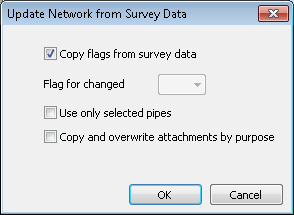Updating Pipe Condition from CCTV Data
Once you have imported CCTV data into the network and calculated condition grades, you can use the CCTV condition information to update pipe and connection pipe condition fields (Structural Condition Grade and Service Condition Grade) for the pipes in the network. Every time you import more recent CCTV data, you can update your pipes again.
To update pipe condition from CCTV data:
- With the network open, choose Update
pipe condition from CCTV from the Network
menu. This displays the Update
Network from Survey Data dialog.
 Show me
Show me - In this dialog, select the flag options:
- Import any flags stored with the survey data
- Set a default flag for all imported data
- Click OK to continue the update.
InfoAsset Manager updates pipe condition fields, the pipe Condition Survey Date field and the Likelihood score field with the most recent CCTV Survey for that pipe according to the Updating Rules listed below. The Current field of the CCTV Survey used for update is checked (see Identifying "Current" CCTV Surveys below).
A message log is displayed showing how many pipes have been updated and any warning messages.
Updating rules
A CCTV Survey can be flagged to be ignored for the purpose of updating pipe condition. This may be done if the survey has been abandoned and is therefore not representative of the pipe's actual condition, for example.
A CCTV Survey with the Ignore for Pipe Updates field checked will not be used when updating pipe condition.
Condition information of pipes in the network is updated from CCTV data that is not flagged to be ignored according to the following rules:
- The most recent CCTV survey is considered first. If the survey covers the entire pipe length then this survey controls the pipe condition. The pipe grade is then set to be the grade of the survey.
- If the most recent CCTV survey covers only part of the pipe, then the most recent survey from the other end of the pipe is also used (if available). The pipe grade is then set to be the worst grade of these two surveys.
- In all of these cases, setting the override grade (structural or service) will cause the override grade to be used in preference to the calculated grade. This allows engineering expertise to take precedence over the automatic scoring process.
Ignoring "Current" CCTV surveys
If a Current survey for a pipe is flagged to be ignored, there are some additional updating rules that should be noted.
For Current Surveys with the Ignore for Pipe Updates field checked, InfoAsset Manager searches for any available previous surveys for the associated pipe:
- If previous surveys are available, the condition fields and Condition Survey Date of the pipe will be updated using the most recent previous survey for the pipe. The Current field of the CCTV Survey to be ignored will be cleared, and the Current field of the survey used for update will be checked.
- If there are no previous surveys available, the Condition Survey Date of the pipe will be cleared but the pipe condition fields data will remain. A warning message to this effect will be displayed in the update log.
Identifying "Current" CCTV surveys
The Current field of a CCTV Survey can be used to show which surveys have been used to update the network. The field can be viewed on the CCTV Survey Grid Window of the Survey Grid and the Definition Page of the CCTV Survey Property Sheet.
On update of the network from CCTV Surveys, the most recent survey for a pipe (that is not flagged to be ignored) will be used to update the network. The Current field of the most recent survey will be checked. If an earlier survey for the pipe exists that was previously used to update the network, the Current field of the earlier survey will be unchecked.
Current surveys can also be identified by:
- Selecting the Navigate tool in the pipe/CCTV property sheet, which will show an asterisk next to the CCTV survey that is current
- Querying the current field in the SQL tool using "Current = 1"
- Setting options on the Pipe Symbol tab on the Geoplan Property page to display the defects that are currently applicable to the pipe.

